Overview
Every year, approximately 3.4 million deaths worldwide are linked to type 2 diabetes. This staggering statistic highlights a significant public health crisis that calls for urgent intervention and improved management strategies. It's understandable to feel overwhelmed by such alarming news, but please know that there is hope and help available.
In the U.S., type 2 diabetes stands as the seventh leading cause of death. This emphasizes the critical need for preventive measures and lifestyle changes to reduce fatalities associated with this disease. Remember, you are not alone in this journey. Many individuals are facing similar challenges, and together, we can foster a supportive community that encourages healthier choices.
Consider reaching out for resources or support that can guide you through this process. Your health matters, and taking the first step can lead to positive changes. We are here to support you every step of the way.
Introduction
Type 2 diabetes is not just a personal health issue; it represents a growing public health crisis with profound implications for global mortality rates. It's understandable to feel overwhelmed by the statistics, which reveal a staggering 3.4 million deaths attributed to diabetes worldwide in 2024, with Type 2 diabetes at the forefront of this alarming trend. As healthcare professionals grapple with the rising tide of diabetes-related fatalities—projected to affect over 1.3 billion individuals by 2050—the urgency for effective management and prevention strategies has never been more critical.
This article delves into the stark realities of Type 2 diabetes, exploring its far-reaching impact and the disparities faced by various communities. We understand that this can be a daunting journey, and it highlights the vital need for comprehensive solutions that empower individuals to take control of their health. Through real-world examples and actionable insights, we aim to illuminate the path forward in combating this escalating epidemic. Remember, you're not alone in this journey; we are here to support you every step of the way.
T2DSolutions: Essential Statistics on Type 2 Diabetes Deaths
Type 2 diabetes mellitus presents a significant public health challenge, underscored by alarming statistics that reveal its extensive impact. In 2024, the International Diabetes Federation reported that this condition was responsible for approximately 3.4 million deaths globally, with type 2 diabetes deaths per year significantly contributing to this toll. In the United States, the Centers for Disease Control and Prevention (CDC) identified this condition as the seventh leading cause of death, accounting for type 2 diabetes deaths per year that exceed 100,000 fatalities. It's understandable to feel overwhelmed by these numbers, but this stark reality emphasizes the critical need for effective management and prevention strategies to combat the rising tide of complications related to diabetes-related mortality.
The mortality rates associated with Type 2 diabetes are projected to escalate further. Research indicates that by 2050, over 1.3 billion individuals could be affected globally. This alarming trend highlights the urgency for comprehensive action to tackle the epidemic of blood sugar disorders. In the U.S., statistics reveal that the annual relative increase in Type 2 health issues from 2002 to 2012 was 4.8%. This trend continues to raise concerns among healthcare professionals and underscores the need for immediate intervention.
Real-world examples illustrate the effectiveness of comprehensive management plans, which include lifestyle modifications and appropriate medical care. For instance, successful case studies have shown that individuals who embrace a balanced diet and regular exercise can significantly lower their blood sugar levels and enhance their overall well-being. By nurturing a supportive community and sharing experiences, organizations aim to improve health outcomes and empower individuals to manage their condition effectively. You're not alone in this journey.
To assist those recently diagnosed, T2DSolutions promotes involvement in community support groups and provides educational resources that offer practical advice for managing the condition. Furthermore, the CDC reports that the number of adults with diagnosed prediabetes is substantial, with:
- 61.8 million non-Hispanic whites
- 15 million Hispanics
- 12.3 million non-Hispanic Blacks
- 5.8 million Asian Americans
This diverse impact highlights the importance of tailored management strategies for different populations. We are here to support you every step of the way.
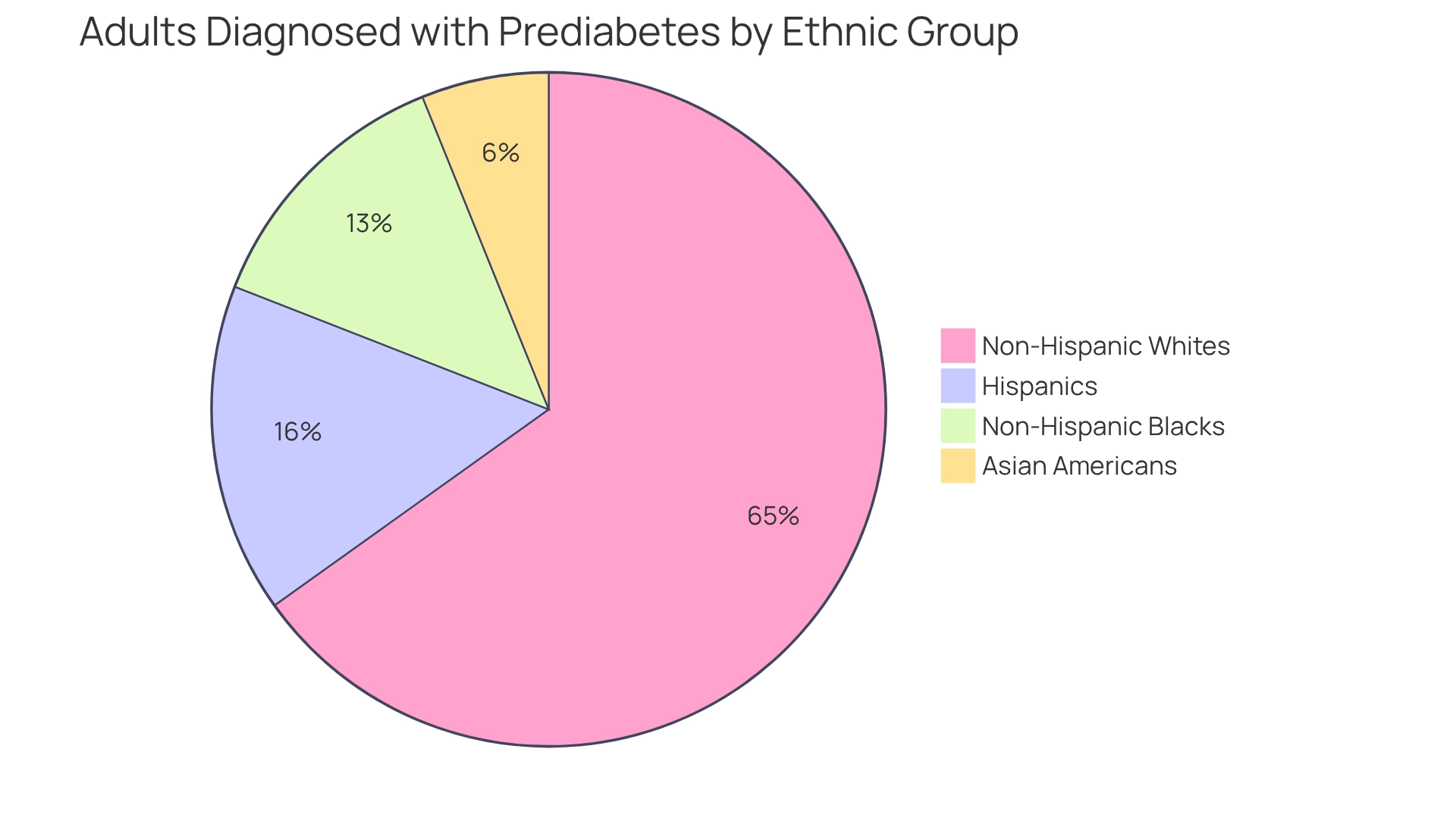
1. 1.5 Million Deaths Annually Linked to Type 2 Diabetes
Each year, the number of type 2 diabetes deaths per year is approximately 1.5 million, underscoring the severity of this condition and the urgent need for improved management strategies. This figure translates to a staggering frequency of one death every 9 seconds, underscoring the critical nature of type 2 diabetes deaths per year as a significant health crisis. In 2024, there were 3.4 million type 2 diabetes deaths per year, further emphasizing the need for proactive measures. Many of these fatalities are preventable through lifestyle changes, early diagnosis, and effective treatment plans.
The Centers for Disease Control and Prevention (CDC) states that complications resulting from diabetes-related conditions, such as cardiovascular disease and kidney failure, greatly contribute to this mortality rate. It's understandable to feel overwhelmed by these statistics, but it's important to remember that individuals with this condition are twice as likely to experience depression compared to those without it. This highlights the mental wellness challenges that accompany diabetes.
By adopting healthier habits, seeking timely medical intervention, and addressing mental health, you can dramatically reduce your risk of preventable deaths associated with Type 2 diabetes. We are here to support you every step of the way. Organizations like T2DSolutions are dedicated to tackling these concerning statistics by offering educational resources, community support, and expert guidance to empower newly diagnosed patients.
Through collaboration with experts and advocacy groups, T2DSolutions ensures the accuracy and relevance of the information shared, helping you trust the resources provided. Taking proactive steps today can lead to a healthier tomorrow. Remember, you're not alone in this journey; together, we can work towards a brighter future.
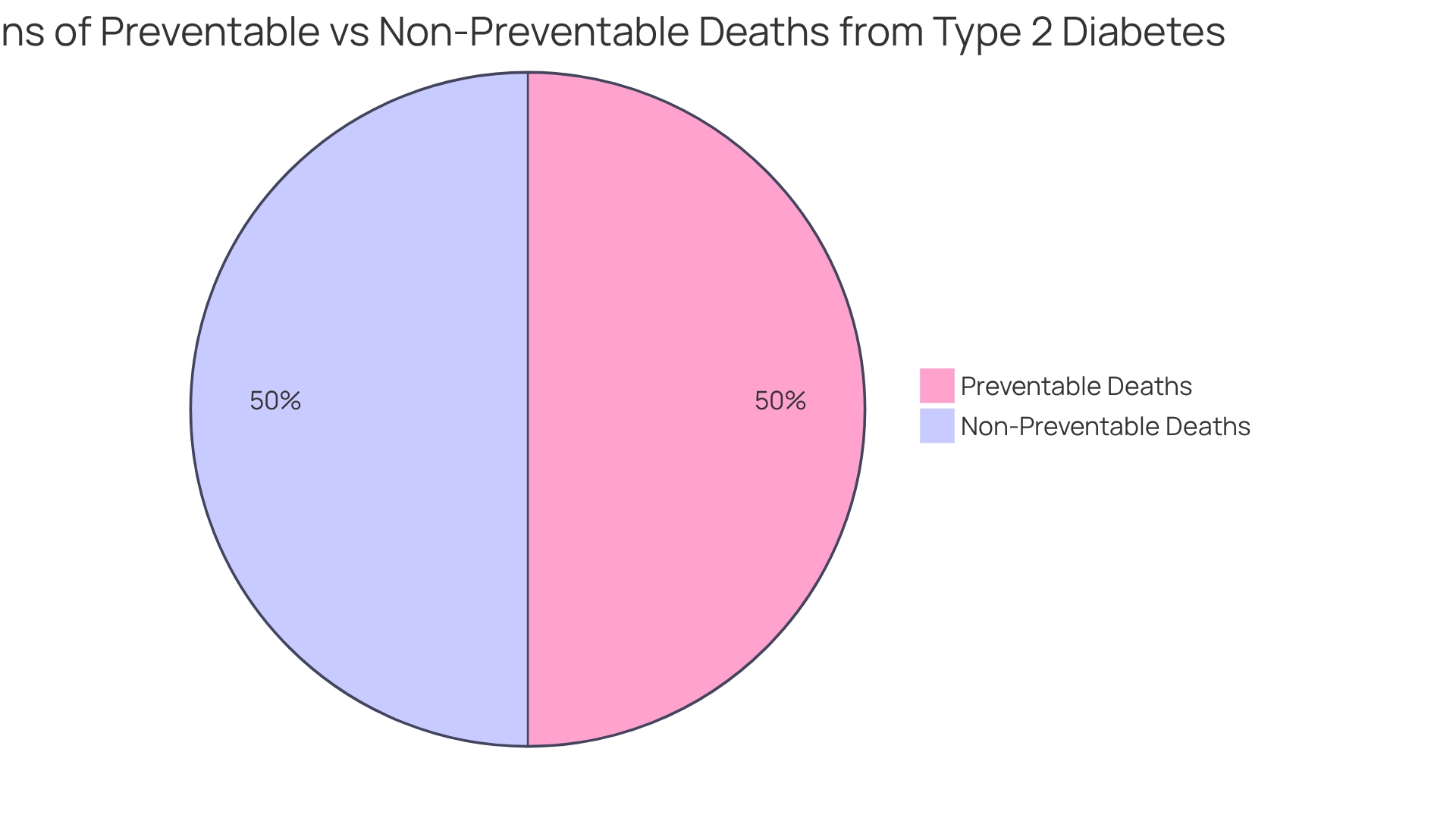
2. 62% Increase in Type 2 Diabetes Deaths Among Youth Post-COVID-19
Recent research highlights a staggering 62% increase in type 2 diabetes deaths per year among youth following the COVID-19 pandemic. It’s understandable to feel concerned about this trend, which is primarily influenced by rising obesity levels and a notable decrease in physical activity during lockdowns. The pandemic has not only heightened existing health inequalities but also emphasized the urgent need for healthcare systems to address the specific needs of younger individuals diagnosed with this condition.
A study investigating healthcare usage shows that enhanced access to medical services is linked with increased occurrences of the condition among young people. This indicates that proactive healthcare involvement is essential for early detection and efficient management. However, there is a lack of information regarding socioeconomic, racial, and ethnic differences in the occurrence of the disease during the COVID-19 pandemic. Addressing this void is crucial to guide fair strategies for intervention, as tackling these challenges is essential to mitigate the long-term impacts of COVID-19 on type 2 diabetes deaths per year among young individuals.
For newly diagnosed patients, it is vital to engage with healthcare providers regularly to monitor health and access necessary resources. Remember, you’re not alone in this journey; T2DSolutions aims to be a comprehensive resource hub, providing education and support to help you navigate these challenges effectively. We are here to support you every step of the way.
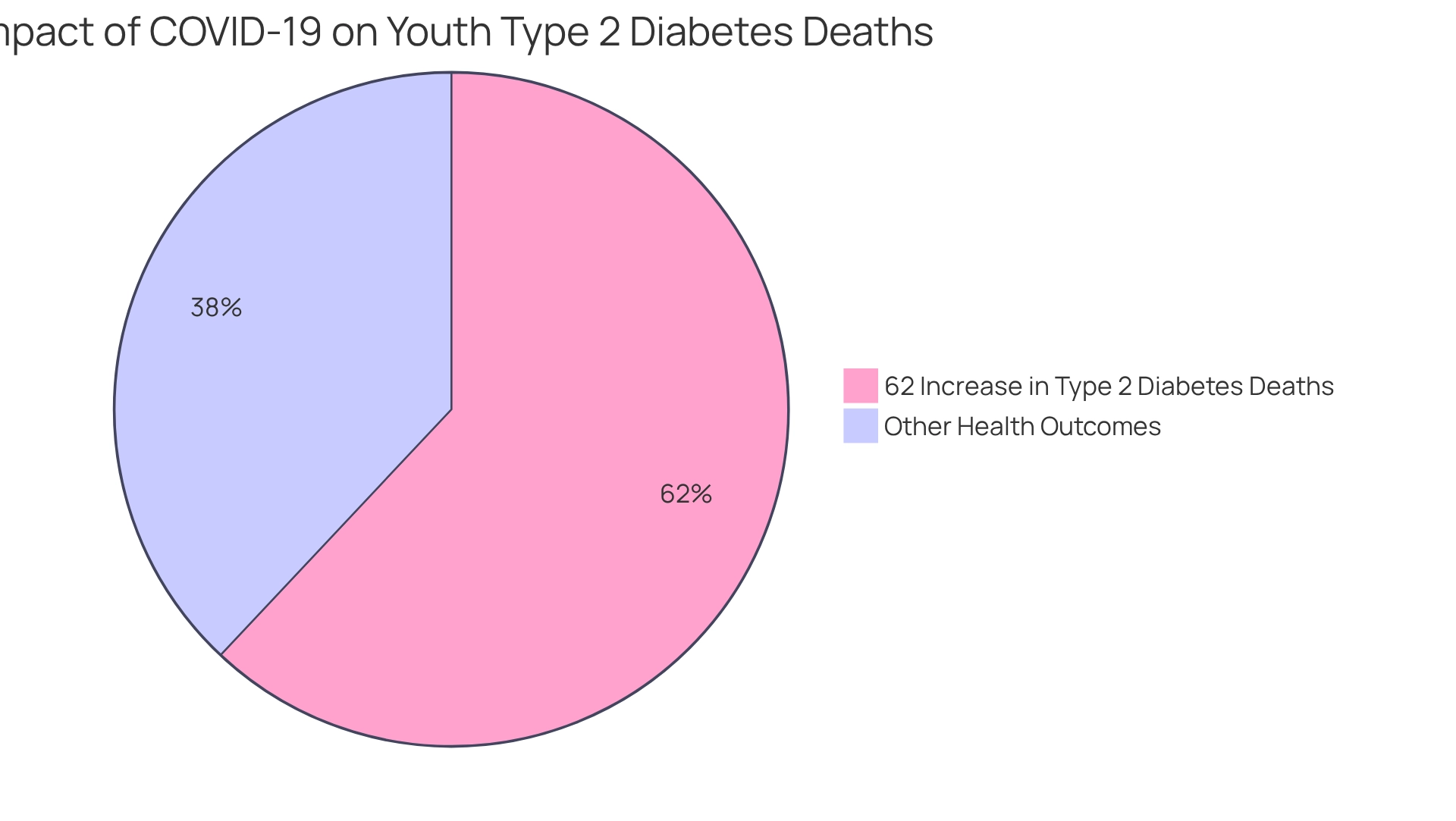
3. Black and Hispanic Communities Face Higher Diabetes Death Rates
Recent information reveals a troubling reality: Black and Hispanic communities face significantly higher mortality rates from diabetes-related issues than their white counterparts. For instance, non-Hispanic Black adults are 1.4 times more likely to experience complications from diabetes. This alarming disparity is largely influenced by socioeconomic factors, such as limited access to healthcare, higher obesity rates, and systemic inequities rooted in segregation and racism, which ultimately deteriorate health outcomes. In Massachusetts, Black non-Hispanic residents experienced emergency department visits over four times more frequently than their White non-Hispanic neighbors. This highlights an urgent need for targeted interventions to address these disparities, which vary greatly across different cities.
In light of these challenges, T2DSolutions strives to be a comprehensive resource hub, offering education and community support for blood sugar management. A case study from 2020 indicated that 77.6% of non-Hispanic Black adults with elevated blood sugar levels received at least two hemoglobin A1c measurements, closely mirroring the 80.7% rate among non-Hispanic whites. According to the CDC, this statistic underscores the importance of regular monitoring in managing blood sugar levels. While these comparable figures suggest some degree of access to care, they also highlight the ongoing need for support to maintain these levels. T2DSolutions is committed to providing resources and practical advice to help newly diagnosed patients effectively manage their condition and navigate these disparities. Addressing these inequalities is vital, not just for improving individual wellness outcomes, but also for reducing the type 2 diabetes deaths per year within our communities. You're not alone in this journey; we are here to support you every step of the way.
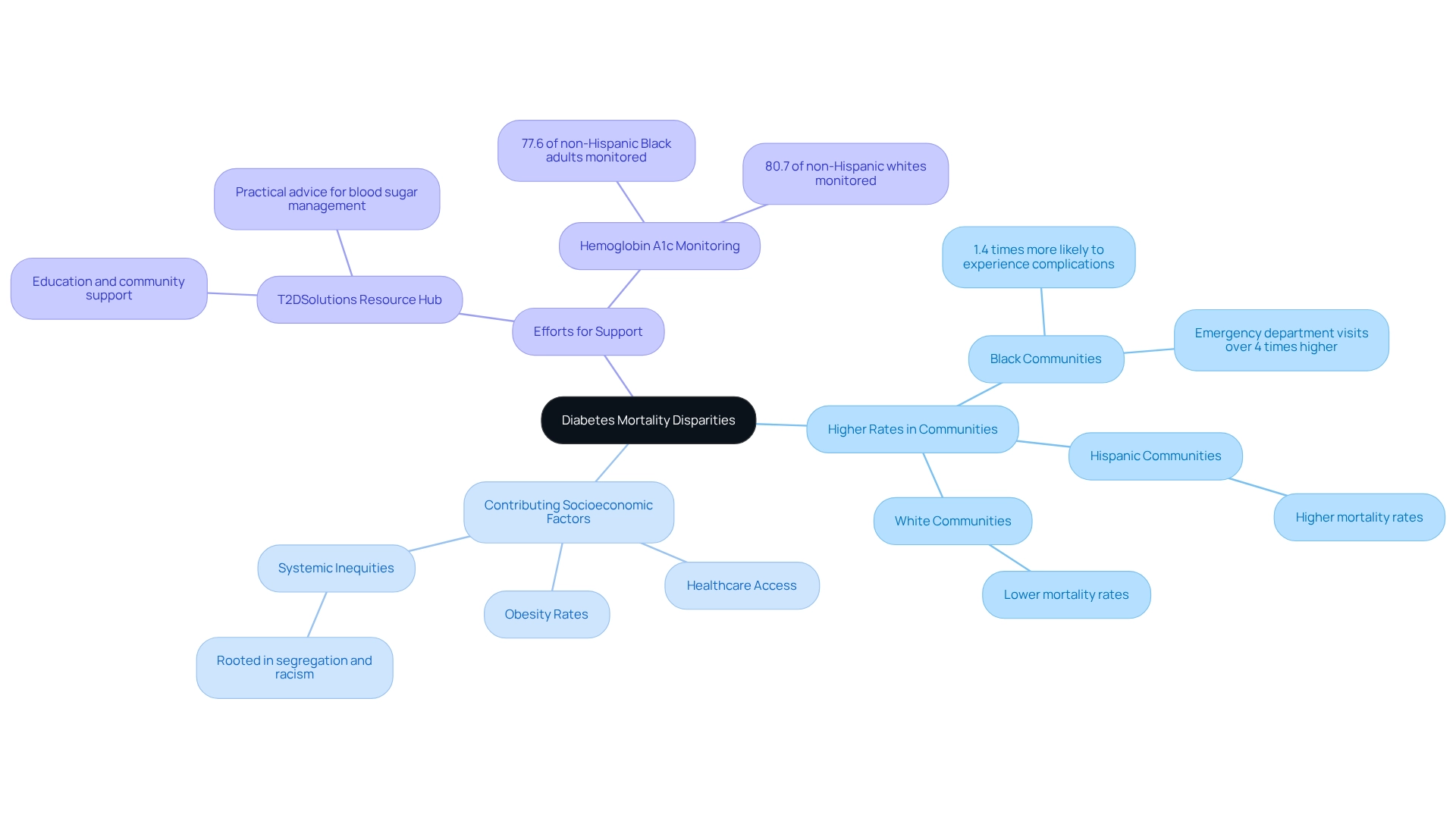
4. 50% of Individuals with Type 2 Diabetes Develop Serious Complications
Nearly 50% of individuals diagnosed with Type 2 conditions may encounter serious complications, such as heart disease, kidney failure, and neuropathy. These complications not only increase the risk of mortality—there are approximately 1.5 million type 2 diabetes deaths per year, as estimated in 2012 by the World Health Organization (WHO)—but they also significantly impact overall quality of life. For instance, diabetes is linked to a heightened risk of depression, with those affected being twice as likely to experience emotional challenges compared to individuals without the condition. This connection underscores how complications can worsen mental health issues.
At T2DSolutions, we recognize how crucial effective management strategies are, including regular monitoring, following treatment plans, and making lifestyle changes, to help mitigate these risks. Case studies focused on lifestyle management in blood sugar regulation have demonstrated that adopting healthier habits can lead to better glucose control and a notable decrease in the risk of complications. By prioritizing comprehensive care, individuals can enhance their health outcomes and maintain a higher quality of life, even in the face of challenges posed by the condition.
To start managing your condition effectively, consider reaching out to a healthcare provider to develop a personalized plan that incorporates dietary adjustments and regular physical activity. Additionally, our organization offers valuable resources and community support to assist you in navigating your journey. Remember, you’re not alone in this journey; we are here to support you every step of the way.
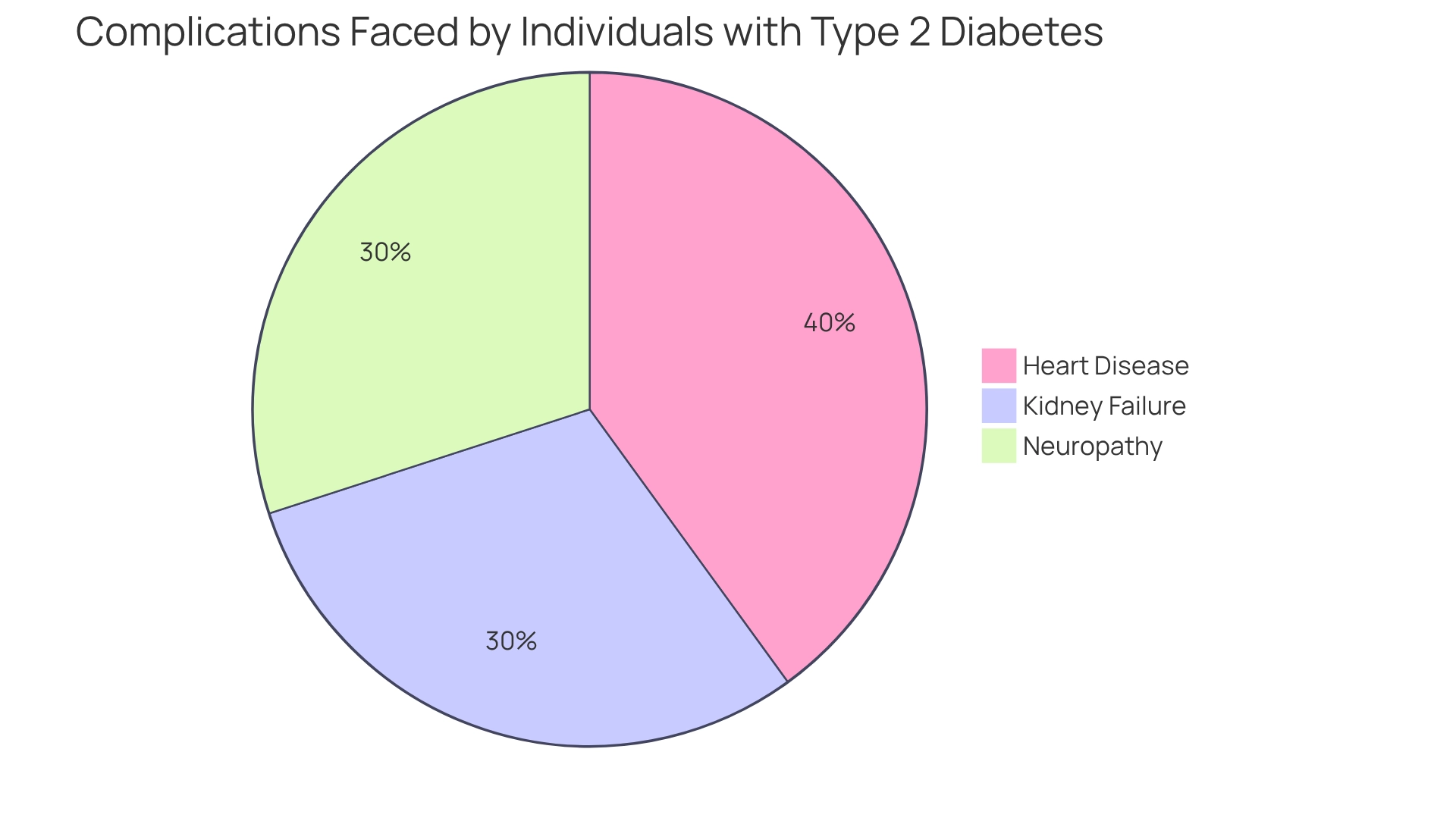
5. $327 Billion Annual Cost of Diabetes-Related Deaths in the U.S.
The annual economic burden of diabetes-related deaths in the United States is a staggering $327 billion. This figure encompasses direct medical expenses, lost productivity, and various costs associated with managing the condition and its complications. Such a significant financial impact underlines the urgent necessity for effective preventive measures and educational initiatives, which T2DSolutions is dedicated to providing. By offering resources and community assistance, T2DSolutions aims to alleviate the financial burden of this condition while enhancing public wellness outcomes.
As highlighted in the case study 'Future Directions for Diabetes Prevention,' continuous prevention programs and interventions are crucial for reducing the effects on well-being and economic factors linked to this condition. Investing in these strategies not only eases economic strains but also lowers the incidence of diabetes and its associated mortality. Charles “Chuck” Henderson, CEO of the American Diabetes Association, emphasizes this pressing need, stating, "As we continue our fight to end this condition, we urge policymakers and the entire health care system to see this report as a call to action to prioritize affordable care for those affected."
Furthermore, it is estimated that around 28,000 type 2 diabetes deaths per year are linked to diabetes, with kidney disease being the primary cause. This statistic further illustrates the severity of complications associated with the condition and the importance of effective management strategies. If you're newly diagnosed, we encourage you to connect with T2DSolutions for support and resources tailored to your needs. You're not alone in this journey, and we are here to support you every step of the way.
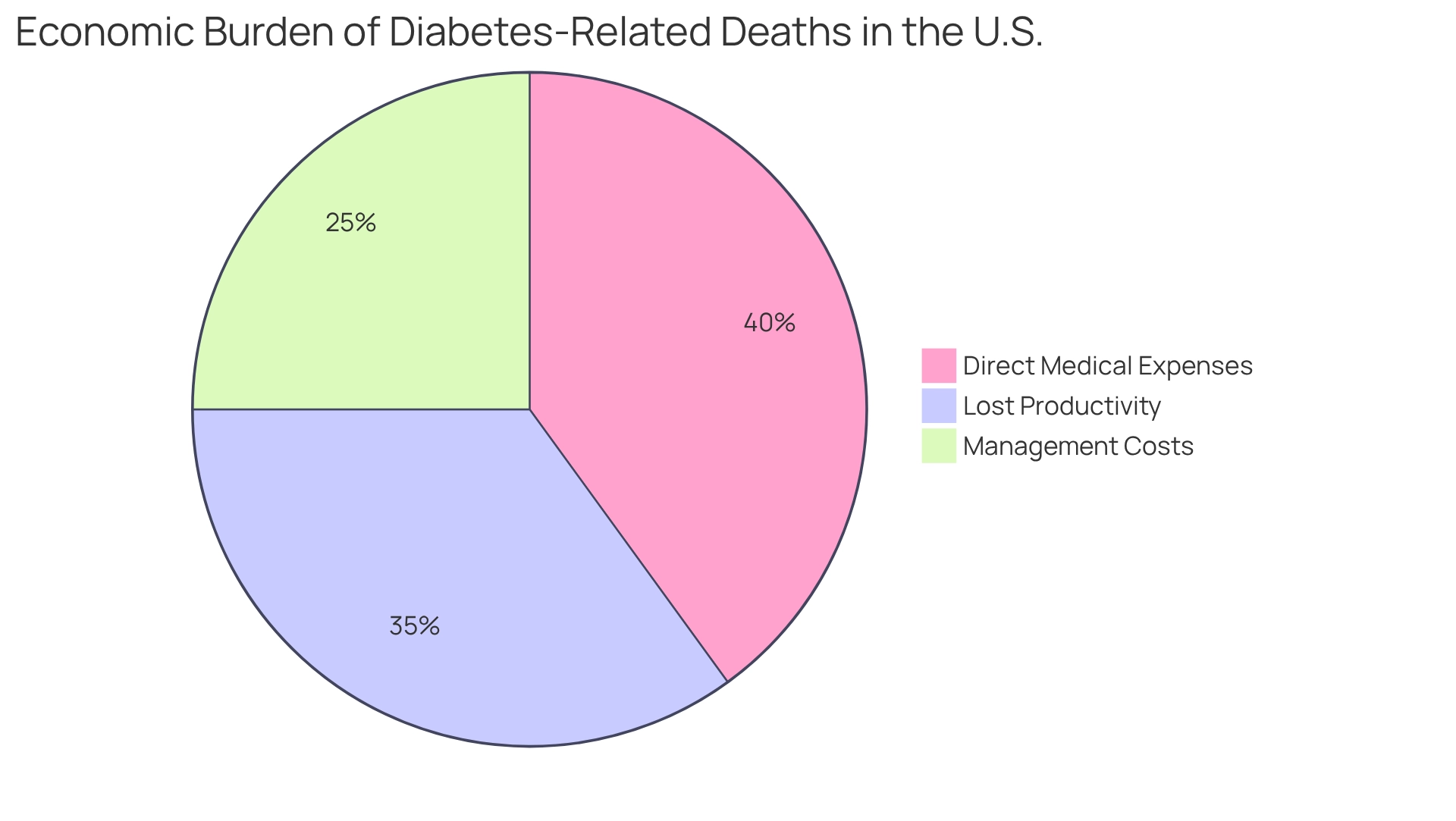
6. 30% Increase in Type 2 Diabetes Cases Over the Last Decade
Over the past decade, we’ve seen a troubling 30% increase in identified instances of Type 2 conditions, highlighting a concerning trend in community wellness. This rise is largely linked to increasing obesity rates, sedentary lifestyles, and significant dietary changes. Obesity, a major risk factor for blood sugar issues, has reached alarming levels. Many individuals are adopting unhealthy eating habits that contribute to weight gain and insulin resistance.
To combat this growing epidemic, effective public health initiatives are essential. Programs that promote healthy eating and encourage physical activity can play a vital role in reversing these trends. Community-oriented initiatives that emphasize nutrition education and accessible exercise opportunities have shown promise in reducing the occurrence of diabetes-related conditions. Additionally, targeted screenings and health programs in low and middle-income nations are crucial for identifying at-risk groups and providing necessary support.
Recognizing the urgency of addressing these issues, our organization is excited to announce the launch of a new resource center dedicated to empowering individuals and families through comprehensive management resources. By offering education, community support, and holistic care, T2DSolutions aims to foster healthier lifestyles and improve access to healthcare resources. We invite you to subscribe for updates and stay informed about our upcoming features and events.
Recent studies reveal significant increases in Type 2 health issue diagnoses among youth, particularly in non-Hispanic Black and Hispanic communities. Data from the SEARCH for Diabetes in Youth study indicates alarming rises in incidence among these groups from 2002 to 2018, underscoring the need for immediate public health responses. Furthermore, the financial burden of this condition is substantial, with excess medical costs per individual rising from $10,179 in 2012 to $12,022 in 2022. As the landscape of this condition continues to evolve, a collective effort, supported by resources like T2DSolutions, is imperative for reversing the alarming trajectory of Type 2 cases. You're not alone in this journey—together, we can make a difference.

7. 80% of Type 2 Diabetes Deaths Linked to Obesity and Sedentary Lifestyle
Research shows that about 80% of fatalities linked to Type 2 conditions stem from obesity and a sedentary lifestyle. These factors play a significant role in insulin resistance and various metabolic disorders, which can increase the risk of serious complications related to blood sugar issues. It's understandable to feel concerned about this. However, there is hope. Individuals who engage in regular exercise and adopt healthier eating habits can significantly lower their mortality risk associated with Type 2 conditions. Case studies reveal that lifestyle changes, such as structured exercise programs and dietary adjustments, lead to better health outcomes and lower mortality rates among patients.
The impact of a sedentary lifestyle on mortality related to blood sugar disorders cannot be overstated. It’s crucial for healthcare providers to advocate for active living as a preventive measure. By focusing on these lifestyle factors, our organization aims to offer resources and support to help those recently diagnosed manage their condition effectively. Together, we can work towards reducing the alarming statistics surrounding type 2 diabetes deaths per year in 2025 and beyond. Remember, you’re not alone in this journey—we are here to support you every step of the way.
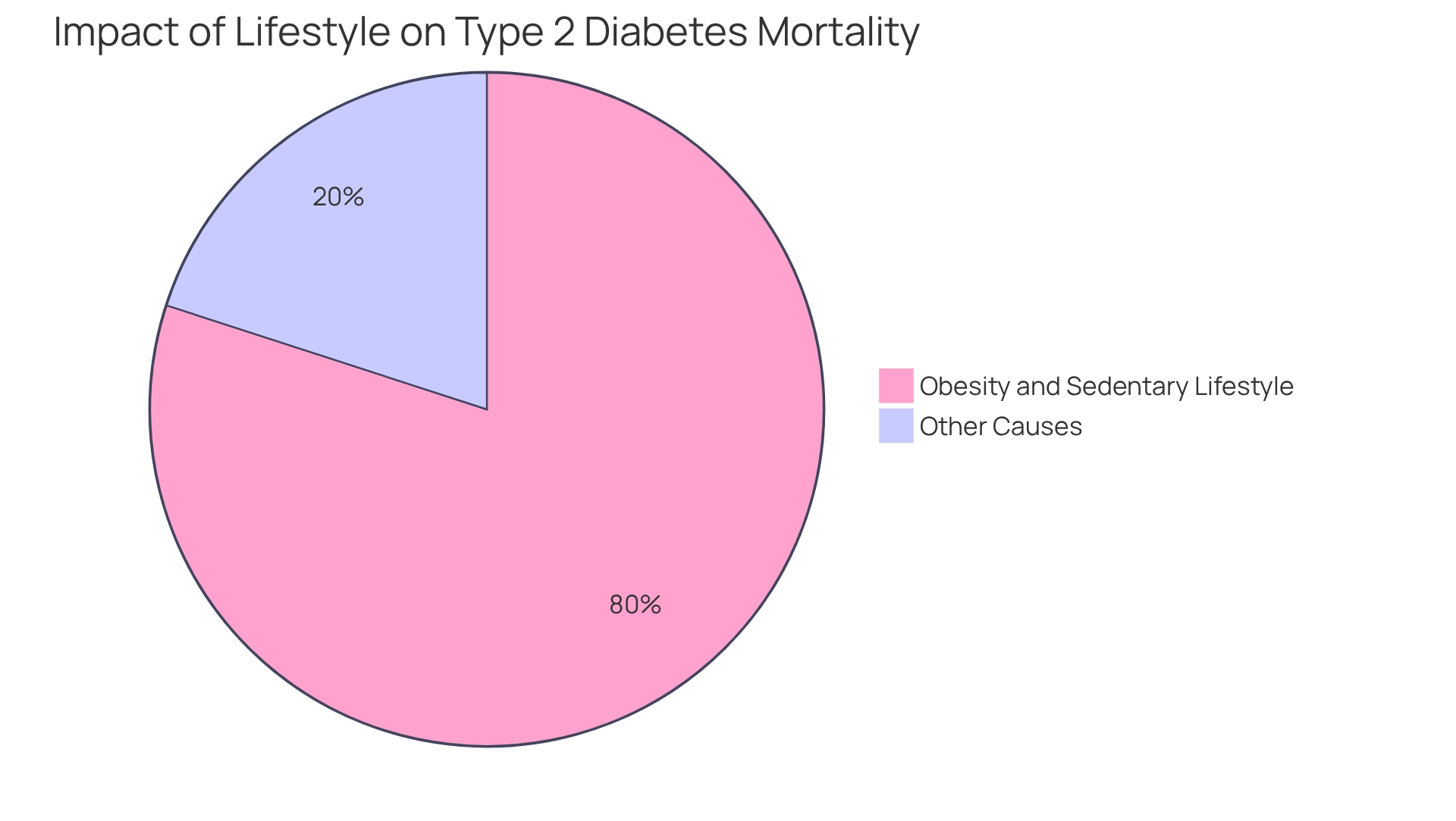
8. Early Diagnosis Can Reduce Type 2 Diabetes Deaths by 50%
Recognizing Type 2 diabetes mellitus early can significantly reduce mortality rates, potentially leading to a decrease in type 2 diabetes deaths per year of up to 50%, according to studies. It's understandable to feel overwhelmed, but timely intervention can empower you to adopt effective management strategies. These include lifestyle changes and appropriate medications, which are vital in preventing disease progression and its complications.
Our organization serves as a crucial resource center, offering assistance and tools to help newly diagnosed individuals manage their condition effectively. Regular screenings and awareness campaigns are essential in promoting early detection, ensuring you receive the guidance you need.
Programs like intensive glucose monitoring initiatives have shown substantial benefits for patients with heart conditions, highlighting the importance of early intervention in comprehensive metabolic care. Moreover, viewing hyperglycemia as a continuum rather than relying solely on traditional glucose and HbA1c cutoffs emphasizes the need for timely diagnosis and personalized management strategies.
At T2DSolutions, we are committed to providing shared information and support, leading to improved wellness outcomes and strengthening our collective journey in managing this condition. Remember, you're not alone in this journey; we are here to support you every step of the way.
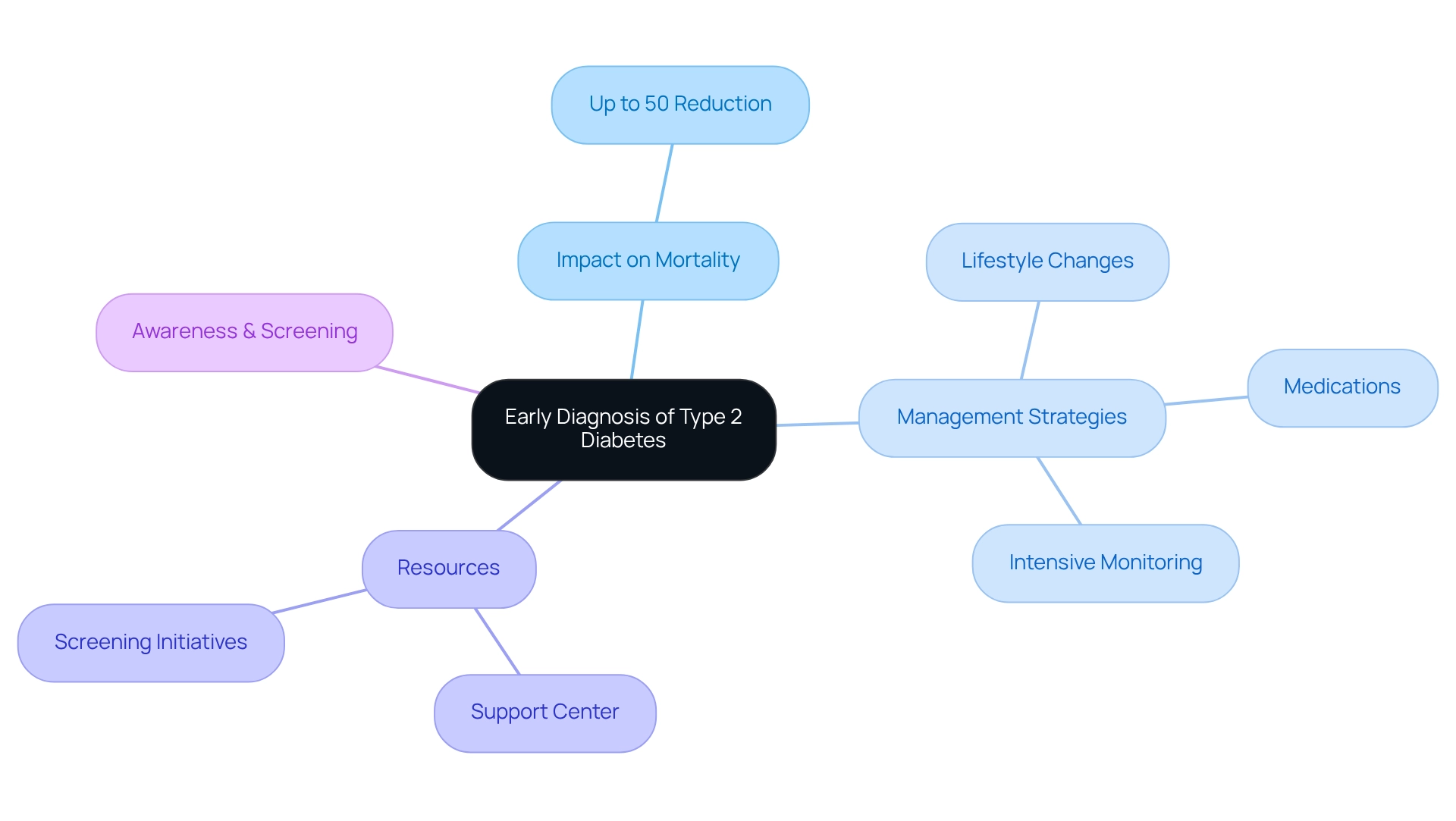
9. Global Diabetes Deaths Expected to Reach 4 Million by 2030
By 2030, it's estimated that there will be 4 million type 2 diabetes deaths per year worldwide due to diabetes-related conditions. This alarming prediction highlights the urgent need for comprehensive measures to address this health crisis. It's crucial to focus on prevention strategies, education, and improved healthcare access to lessen the impact of this escalating public health challenge. Collaborative efforts among healthcare providers, policymakers, and communities are essential in effectively combating this epidemic.
For instance, innovative therapies like tirzepatide have shown remarkable potential, reducing the risk of type 2 diabetes in prediabetic adults by an impressive 94%. As the burden of complications related to type 2 diabetes continues to grow, with studies indicating a heavier burden among those affected, we must prioritize initiatives aimed at enhancing care and prevention for this condition. T2DSolutions is committed to addressing these challenges by providing resources and support for individuals and families impacted by diabetes, particularly in light of the projected decrease in type 2 diabetes deaths per year from 1,472,934 to 1,165,361 by 2030, suggesting that with the right strategies, we can make meaningful progress in lowering mortality rates. In South and Central America, the number of people living with diabetes is expected to rise by 48%, reaching 49 million by 2045. This underscores the necessity for improved diabetes care and prevention programs in these regions.
Real-world examples of successful collaborative efforts, such as community health initiatives and educational programs, can serve as inspiring models for future actions. They reinforce the belief that a united approach is vital in addressing this epidemic. Remember, you're not alone in this journey; we are here to support you every step of the way.
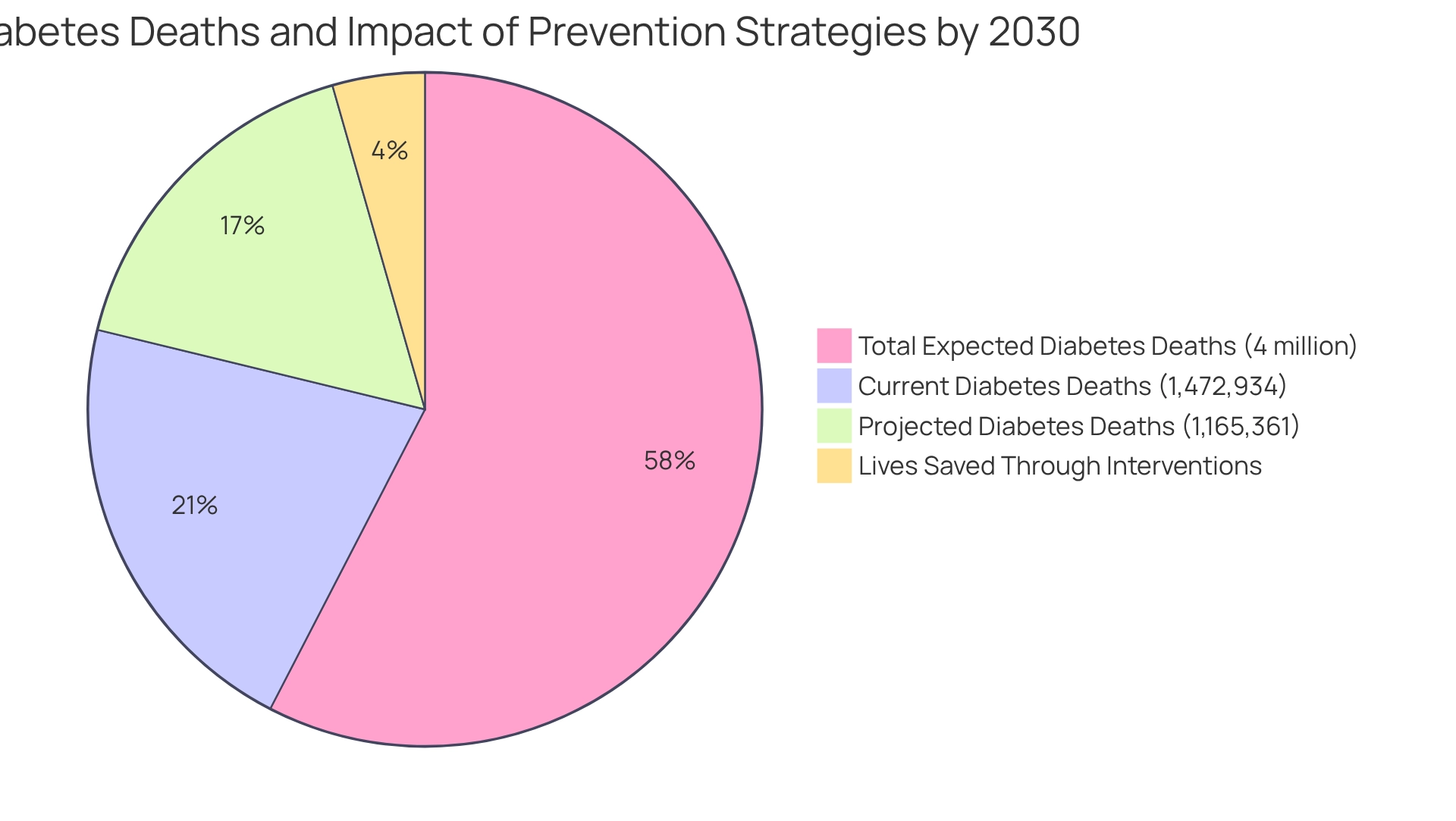
Conclusion
Type 2 diabetes is a pressing public health crisis that requires our immediate attention and action. It's staggering to think that approximately 3.4 million deaths globally were attributed to diabetes in 2024, with Type 2 diabetes being a significant contributor. The projected rise in cases, particularly among youth and marginalized communities, highlights the urgent need for effective management and prevention strategies. As mortality rates continue to climb, it's clear that lifestyle modifications, early diagnosis, and comprehensive care are essential in combating this epidemic.
Disparities in diabetes outcomes remind us of the importance of tailored interventions, especially for Black and Hispanic communities who face higher mortality rates. Educational resources and community support empower individuals to take control of their health. T2DSolutions is committed to bridging these gaps by providing accessible information and fostering supportive environments for those navigating their diabetes journey. We cannot overlook the connection between obesity, sedentary lifestyles, and diabetes deaths; promoting active living and healthy dietary choices is crucial.
Looking ahead, the projected increase in diabetes-related deaths by 2030 serves as a stark reminder of the work that still lies ahead. By prioritizing early diagnosis, innovative treatments, and community engagement, we can significantly reduce mortality rates and improve the quality of life for individuals affected by Type 2 diabetes. Collective efforts from healthcare providers, policymakers, and communities are vital in effectively addressing this escalating epidemic. Embracing a proactive approach today will pave the way for a healthier tomorrow, ensuring that no one faces this challenge alone.
Frequently Asked Questions
What is the significance of type 2 diabetes mellitus as a public health challenge?
Type 2 diabetes mellitus presents a significant public health challenge, with the International Diabetes Federation reporting approximately 3.4 million deaths globally in 2024. In the U.S., it is the seventh leading cause of death, with over 100,000 fatalities annually.
How are the mortality rates for type 2 diabetes projected to change in the future?
Mortality rates associated with type 2 diabetes are projected to escalate, with estimates suggesting that over 1.3 billion individuals could be affected globally by 2050. The annual relative increase in type 2 health issues in the U.S. from 2002 to 2012 was 4.8%.
What strategies are effective in managing type 2 diabetes?
Comprehensive management plans, including lifestyle modifications like a balanced diet and regular exercise, have proven effective in lowering blood sugar levels and improving overall well-being.
What resources are available for individuals recently diagnosed with type 2 diabetes?
T2DSolutions promotes involvement in community support groups and provides educational resources that offer practical advice for managing the condition.
What are the statistics regarding prediabetes among different ethnic groups in the U.S.?
The CDC reports substantial numbers of adults with diagnosed prediabetes, including 61.8 million non-Hispanic whites, 15 million Hispanics, 12.3 million non-Hispanic Blacks, and 5.8 million Asian Americans.
How many deaths are attributed to type 2 diabetes each year, and what does this indicate?
Approximately 1.5 million deaths annually are attributed to type 2 diabetes, indicating a severe health crisis that necessitates improved management strategies.
What complications arise from diabetes-related conditions?
Complications from diabetes-related conditions, such as cardiovascular disease and kidney failure, significantly contribute to the mortality rate associated with type 2 diabetes.
How has the COVID-19 pandemic affected type 2 diabetes deaths among youth?
Recent research indicates a 62% increase in type 2 diabetes deaths per year among youth following the COVID-19 pandemic, primarily due to rising obesity levels and decreased physical activity.
What should newly diagnosed patients do to manage their condition effectively?
Newly diagnosed patients should engage regularly with healthcare providers to monitor their health and access necessary resources for effective management.
How does T2DSolutions support individuals with type 2 diabetes?
T2DSolutions offers educational resources, community support, and expert guidance to empower newly diagnosed patients in managing their condition effectively.



